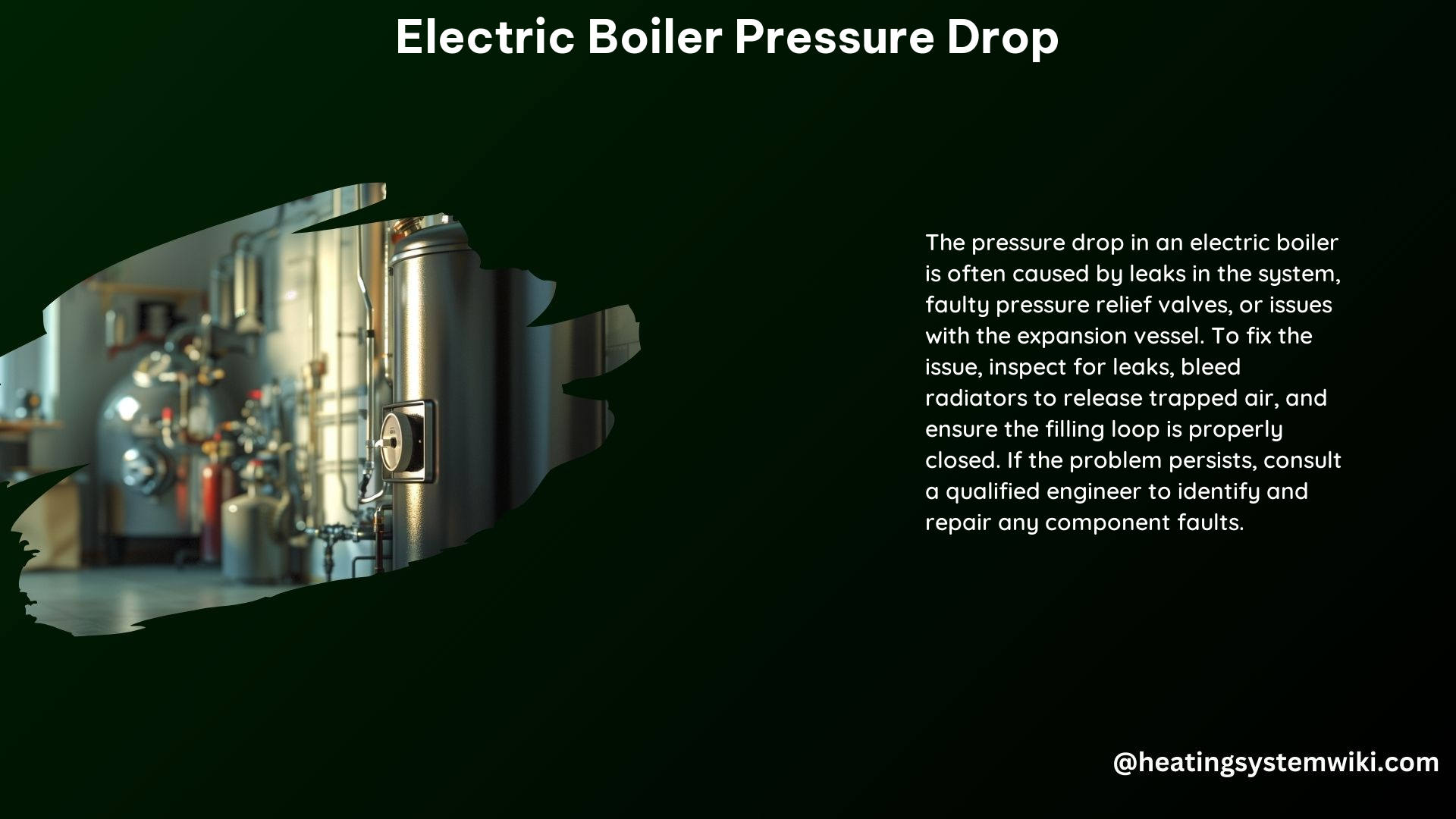Electric boilers are a popular choice for heating homes, offering efficient and environmentally-friendly heating solutions. However, maintaining the correct pressure within the boiler system is crucial for its optimal performance and longevity. In this comprehensive guide, we will delve into the causes of pressure drops in electric boilers, provide effective fixes, and explore the technical specifications you need to know.
Causes of Pressure Drop in Electric Boilers
1. Leaks in the System
Leaks can occur in various components of the electric boiler system, including pipes, radiators, and the boiler unit itself. These small, hard-to-detect leaks can gradually lead to significant pressure drops over time. It’s essential to regularly inspect the entire system for any signs of leakage and address them promptly.
2. Air in the System
Air pockets trapped within the radiators or the expansion vessel can disrupt the pressure balance, resulting in pressure drops. Proper bleeding of the radiators and maintaining the correct air pressure in the expansion vessel are crucial steps to mitigate this issue.
3. Faulty Pressure Relief Valve
The pressure relief valve is designed to release excess pressure from the system to prevent damage. However, if the valve is malfunctioning, it can release too much water, leading to pressure drops. Ensuring the pressure relief valve is functioning correctly is vital.
4. Expansion Vessel Issues
The expansion vessel plays a crucial role in maintaining the correct pressure within the system. Faulty diaphragms or Schrader valves within the expansion vessel can cause pressure imbalances, resulting in pressure drops. Regular maintenance and replacement of the expansion vessel, if necessary, can help resolve this problem.
5. Incorrect Bleeding
Improper bleeding of radiators, where the system is drained without refilling, can lead to pressure drops. It’s essential to follow the manufacturer’s instructions for correctly bleeding the radiators and maintaining the appropriate pressure level.
6. Frozen Condensate Pipes
In cold weather conditions, the condensate pipes can freeze, blocking the water flow and affecting the boiler’s pressure. Insulating the condensate pipes or installing a condensate pump can help prevent this issue.
7. Thermostat Issues
Faulty thermostats or lost connections can disrupt the boiler’s operation, leading to pressure drops. Ensuring the thermostat is functioning correctly and maintaining proper wiring connections is crucial.
Fixing Pressure Drops in Electric Boilers

1. Inspect for Leaks
Carefully inspect the entire electric boiler system, including pipes, radiators, and the boiler unit itself, for any signs of leakage. Repair any identified leaks promptly to restore the system’s pressure.
2. Bleed Radiators
Release any trapped air from the radiators by bleeding them according to the manufacturer’s instructions. This will help reestablish the correct pressure balance within the system.
3. Check Pressure Relief Valve
Ensure the pressure relief valve is functioning correctly. If necessary, replace the valve to prevent excessive pressure drops.
4. Expansion Vessel Maintenance
Maintain the correct air pressure (typically 12 psi) in the expansion vessel and ensure the valve between the vessel and the system is fully open. If the expansion vessel is faulty, consider recharging or replacing it.
5. Re-Pressurize the Boiler
Follow the manufacturer’s instructions to re-pressurize the boiler, ensuring the correct pressure level is reached. This may involve using the filling loop or other designated methods.
Technical Specifications for Electric Boiler Pressure Drop
-
Recommended Pressure Range: The recommended pressure range for electric boilers is typically between 1.0 and 1.5 bar (14.5 to 21.8 psi). Maintaining the pressure within this range is crucial for optimal boiler performance.
-
Pressure Relief Valve: The pressure relief valve is typically set to open at 3 bar (43.5 psi) to prevent the system from exceeding the maximum safe pressure. Ensure the valve is functioning correctly to prevent excessive pressure drops.
-
Expansion Vessel: The expansion vessel should maintain an air pressure of approximately 12 psi (0.8 bar). The valve between the vessel and the system should be fully open to allow for proper pressure regulation.
-
Filling Loop: Use the filling loop, as specified by the manufacturer, to re-pressurize the boiler when necessary. Follow the instructions carefully to ensure the correct pressure level is reached.
By understanding the causes of pressure drops, implementing the appropriate fixes, and adhering to the technical specifications, you can ensure your electric boiler operates at peak efficiency and maintain a comfortable heating environment in your home.
References
- My Trusted Expert. (n.d.). Boiler Losing Pressure: Here’s how to fix it. Retrieved from https://mytrustedexpert.com/blog/boiler-losing-pressure-fix/
- Boiler Central. (2024). Low Boiler Pressure Causes, Fixes And How To Top It Up Yourself. Retrieved from https://www.boilercentral.com/troubleshooting/low-boiler-pressure/
- Reddit. (2023). Low water pressure in my electric boiler. Retrieved from https://www.reddit.com/r/Plumbing/comments/183gok1/low_water_pressure_in_my_electric_boiler/
- Heating Help. (2021). Pressure drop when pump turns on. Retrieved from https://forum.heatinghelp.com/discussion/185228/pressure-drop-when-pump-turns-on
- Viessmann UK. (n.d.). What should I do if my boiler loses pressure? Retrieved from https://www.viessmann.co.uk/en/heating-advice/boilers/boiler-loses-pressure-what-to-do.html
